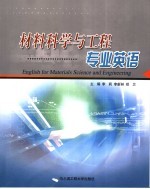图书介绍
材料科学与工程专业英语pdf电子书版本下载

- 李莉,李新林,郑卫主编(哈尔滨工程大学材化学院) 著
- 出版社: 哈尔滨:哈尔滨工程大学出版社
- ISBN:7810738941
- 出版时间:2006
- 标注页数:326页
- 文件大小:23MB
- 文件页数:336页
- 主题词:材料科学-英语-阅读教学-自学参考资料
PDF下载
下载说明
材料科学与工程专业英语PDF格式电子书版下载
下载的文件为RAR压缩包。需要使用解压软件进行解压得到PDF格式图书。建议使用BT下载工具Free Download Manager进行下载,简称FDM(免费,没有广告,支持多平台)。本站资源全部打包为BT种子。所以需要使用专业的BT下载软件进行下载。如 BitComet qBittorrent uTorrent等BT下载工具。迅雷目前由于本站不是热门资源。不推荐使用!后期资源热门了。安装了迅雷也可以迅雷进行下载!
(文件页数 要大于 标注页数,上中下等多册电子书除外)
注意:本站所有压缩包均有解压码: 点击下载压缩包解压工具
图书目录
Part 1 Introduction to Materials Science and Engineering 1
Chapter 1 Introduction 1
1.1 Historical Perspective 1
Catalog 1
1.2 Importance of Materials Science and Engineering 2
1.3 Advanced Materials 3
1.4 Modern Materials Needs 3
Part 2 Physical Foundations of Materials Science 5
Chapter 2 Atomic Structure and Interatomic Bonding 5
2.1 Introduction 5
2.2 Atomic Structure 5
2.3 Electrons in Atoms 6
2.4 The Periodic Table 9
2.5 Atomic Bonding in Solids 11
2.6 Primary Interatomic Bonds 13
3.2 Crystal Structures 20
Chapter 3 The Structure of Crystalline Solids 20
3.1 Introduction 20
3.3 Crystallographic Directions 29
3.4 Crystalline and Noncrystalline Materials 30
Chapter 4 Imperfections in Solids 34
4.1 Introduction 34
4.2 Point Defects 34
4.3 Miscellaneous Imperfection 38
4.4 Grain Size Determination 44
Chapter 5 Diffusion 47
5.1 Introduction 47
5.2 Diffusion Mechanisms 48
5.3 Steady-State Diffusion 50
5.4 Nonsteady-State Diffusion 51
5.5 Factors That Influence Diffusion 53
6.2 Definitions and Basic Concepts 56
Chapter 6 Phase Diagrams 56
6.1 Introduction 56
6.3 Phases 58
6.4 Phase Equilibrium 59
6.5 Equilibrium Phase Diagrams 60
6.6 Interpretation of Phase Diagrams 63
Chapter 7 Phase Transformations in Metals 75
7.1 Introduction 75
7.2 Phase Transformations 76
7.3 Microstructural and Property Changes in Iron-Carbon Alloys 78
7.4 Mechanical Behavior of Iron-Carbon Alloys 89
Part 3 Physical Properties of Materials 94
Chapter 8 Electrical Properties 94
8.1 Introduction 94
8.2 Electrical Conduction 95
8.3 Energy Band Diagrams and Number of Charge Carriers 100
8.4 Classifications of Conductors 103
8.5 Ionic Conduction Mechanisms 108
8.6 Effects of Defects and Impurites 108
8.7 Superconductivity 111
Chapter 9 Thermal Properties 114
9.1 Introduction 114
9.2 Coefficient of Thermal Expansion 114
9.3 Heat Capacity 117
9.4 Thermal Conduction Mechanisms 118
9.5 Thermal Stresses 120
Chapter 10 Magnetic Properties 124
10.1 Introduction 124
10.2 Basic Concepts 125
10.3 Ferromagnetism 126
10.4 Common Magnets 131
11.2 Optical Properties 137
Chapter 11 Optical Properties 137
11.1 Introduction 137
11.3 Interactions of Light with Solids 138
11.4 Atomic and Electronic Interactions 138
11.5 Optical Properties of Metals 140
11.6 Optical Properties of Non-Metals 141
11.7 Applications of Optical Phenomena 145
Part 4 Mechanical Properties of Materials 150
Chapter 12 Mechanical Properties of Metals 150
12.1 Introduction 150
12.2 Concepts of Stress and Strain 151
12.3 Elastic Deformation 155
12.4 Tensile Properties 159
13.1 Introduction 172
13.2 Dislocations and Plastic Deformation 172
Chapter 13 Dislocations and Strengthening Mechanisms 172
13.3 Mechanisms of Strengthening in Metals 180
13.4 Recovery,Recrystallization and Grain Growth 185
Chapter 14 Failure 188
14.1 Introduction 188
14.2 Fracture 188
14.3 Fatigue 203
14.4 Creep 214
Chapter 15 Corrosion and Degradation 219
15.1 Introduction 219
15.2 Nature of Corrosion 220
15.3 Effect Factors of Corrosion 223
15.4 Types of Corrosion 229
15.5 Determination of Corrosion Characteristics 239
15.6 Corrosion control 241
16.2 Annealing Processes 246
16.1 Introduction 246
Chapter 16 Thermal Processing of Metal Alloys 246
Part 5 Processing 246
16.3 Heat Treatment of Steels 250
16.4 Precipitation Hardening 254
Part 6 Materials and Design 260
Chapter 17 Metal Alloys 260
17.1 Introduction 260
17.2 Fabrication of Metals 260
17.3 Ferrous Alloys 266
17.4 Nonferrous Alloys 271
Chapter 18 Ceramics 280
18.1 Introduction 280
18.2 Ceramic Structures 281
18.3 Ceramic Phase Diagrams 284
18.4 Mechanical Properties 285
18.5 Applications of Ceramics 289
Chaper 19 Polymers 297
19.1 Introduction 297
19.2 Polymerization Reactions 298
19.3 Types of Polymers 302
19.4 Strengthening Mechanisms 305
Chapter 20 Composites 311
20.1 Introduction 311
20.2 Classifications of Composites 312
20.3 Particle-Reinforced Composites 313
20.4 Fiber-Reinforced Composites 315
20.5 Structural Composites 317
Chapter 21 Materials Selection and Design Considerations 320
21.1 Introduction 320
21.2 The Property Spectrum 320
21.3 Selection of Materials 322
21.4 Design with Materials 324